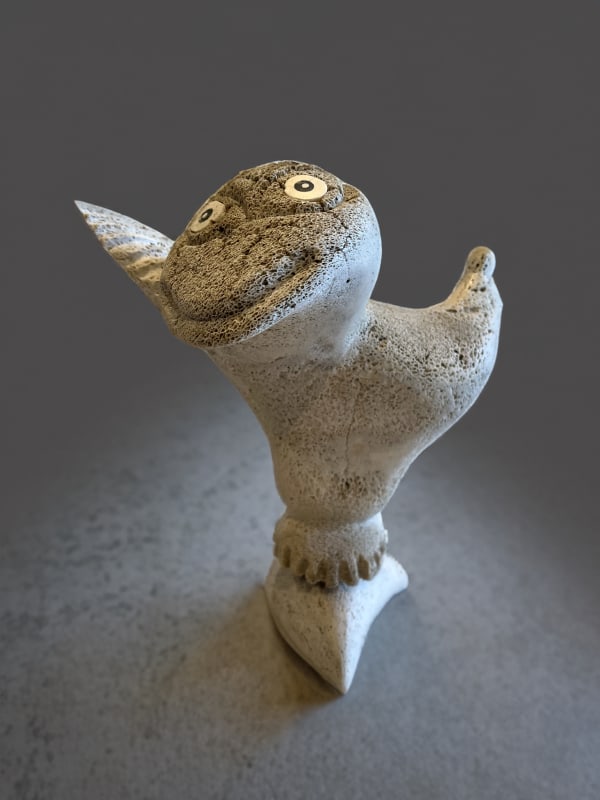Spotlight Feature: From the Price Collection: Whale Bone Masterworks for Sale in the U.S.A.
INTRODUCTION
In an age of regulation and rarity, whale bone carvings are not easy things.
Not to carve. Not to ship. Not to legally collect, especially if you live in the United States, where CITES restrictions, the Endagered Species Act, and the Marine Mammals Protection Act make the import of such works exceptionally difficult, and in many cases, prohibited outright.
Despite these limitations, whale bone has given rise to some of the most distinctive sculptural forms in Arctic art. Artists were not just working within the medium’s constraints, they were working in dialogue with them. What emerged were not standardized forms or workshop styles, but singular visions: sometimes playful, sometimes haunting, and always tied to the material’s stubborn physicality.
A SHORT HISTORY OF WHALE BONE AS CARVING MATERIAL
In the Canadian Arctic, whale bone was never just debris. It was infrastructure, utility, and eventually, art. The Thule culture, ancestors of modern Inuit, used whale bone in everything from house frames to sleds and tools, their lives architected in part by the anatomy of the sea.
When these bones outlasted their original purposes, Inuit artists scavenged them from ancient middens and melting shores, transforming remnants of subsistence into objects of story and form. Recovering whale bone from the remains of Thule sites raises understandable ethical concerns, yet for many artists, these eroding ruins offered some of the only viable sources of material available during the late 1960s through the mid-1970s. While soapstone dominated carving in many areas of the Arctic, its availability and quality varied significantly by region. In parts of the Arctic, local stone for carving was often coarse, uneven, or entirely absent.
After 1975, whale bone works produced in Canada became increasingly difficult to sell internationally. Under American law, whale bone fell under the Endangered Species Act, and exports and imports, especially into the U.S., were sharply restricted [1].
Today, these works are rare not only because few are made but because even fewer are allowed to cross borders. What remains is an art form born from necessity, redefined by imagination, and made scarce by regulation.
1. Under the Convention on International Trade in Endangered Species of Wild Fauna and Flora (CITES), the U.S. Endangered Species Act of 1973 restricted the import of whale bone carvings unless accompanied by extensive documentation proving the material was legally sourced and not obtained from contemporary whale harvests. Shipments from Canadian Arctic Producers were seized, and artists were discouraged from using whale bone for works intended for sale abroad. Even today, U.S. permits for whale bone carvings are rare and generally granted only for non-commercial purposes such as scientific or museum exhibition.
WHALE BONE AS MEDIUM, VOICE, AND VESSEL
As a medium, already shaped by time and tide, whale bone naturally invited ambition. Its varied size, shape, texture, and density offered artists something entirely new that was both physically demanding and creatively liberating. This forced artists to work with what was there: to accommodate the porous surface; to navigate embedded sand and lichen; to adapt their vision to the bone’s unpredictable surface. It was a medium that resisted standardization. The resultant works for many were anything but conventional. Sculptures produced in this medium at this time drew not just from standard northern iconography but personal innovation.
Two of the artists represented in this offering, Karoo Ashevak and Nick Sikkuark, used whale bone not merely as a material but as a collaborator. They worked with the material, minding its fragility to coax from the bone miraculous figures that were deeply individualized and wild, like nothing seen before.
Their sculptures, often humourous, unsettling, or otherwise simply enchanting, reflected not just traditional beliefs in shamanism or in traditional imagery but as singular visions, unrepeatable and untethered from stylistic norms. They were, as Jean Blodgett observed in her The Beaver article, “idiosyncratic” [2], and in the context of Arctic carving traditions, that made them remarkable.
Not every artist used whale bone to summon spirits or fracture convention. Some, like Sam Nahaulaituq, also of Spence Bay, turned toward recognition. His dense, multi-faced carving in this offering holds the power of familiarity somewhat abstract and wholly intimate. These might be the faces of ancestors or kin, preserved in bone and in memory.
Similarly, the Walking Caribou by a once known artist, possibly an early work from Repulse Bay, shows the same attentiveness in another register. Sleek and deliberate, its body trots gently forward in nearly fifteen inches of intention. The head is raised, perhaps alerted by some unseen sound. It is not somber, but regal. A pause made permanent.
CONCLUSION
These works, whether eccentric or quietly reverent, speak to a moment of extraordinary material and artistic possibility. They remain rare not only for their physical qualities but for the circumstances that allowed them to come into being at all.
For any of those interested in the acquisition of these works, we welcome your inquiries.
All prices are listed in Canadian dollars and all works are shipped from within the United States. Please consult your state’s import regulations before purchase.
Nadine Di Monte
-

1
KAROO ASHEVAK (1940-1974) TALOYOAK (SPENCE BAY)
Bird Over Worm, c. 1972
whale bone, stone, and ivory, 10 x 8 x 7 in (25.4 x 20.3 x 17.8 cm) -

2
KAROO ASHEVAK (1940-1974) TALOYOAK (SPENCE BAY)
Bird Transformation, c. 1971-72
whale bone, ivory, and stone, 12.5 x 10.5 x 7 in (31.8 x 26.7 x 17.8 cm) -

3
NICK SIKKUARK (1943-2013) UQSUQTUUQ (GJOA HAVEN)
Shaman, c. 1990
whale bone, muskox fur, antler, and string, 19 x 24.5 x 9 in (48.3 x 62.2 x 22.9 cm) -

4
NICK SIKKUARK (1943-2013) UQSUQTUUQ (GJOA HAVEN)
Fanged Shaman (Tooth Pull), 2000
whale bone, muskox horn, and string, 12.5 x 14.5 x 10 in (31.8 x 36.8 x 25.4 cm)







